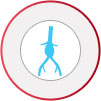Thoracic Aortic Aneurysm
The aorta, the largest artery in the body, transfers blood from the heart to the entire body. The thoracic aorta is the part of the aorta that runs down your chest. Thoracic aortic aneurysm is the bulging of the walls due at a weak area of the thoracic aorta. The bulging may further burst, causing bleeding, and shock or death. Thoracic aneurysm is treated with surgical repair.
Indications
Your doctor may decide to repair the thoracic aneurysm based on various factors. They include:
- Growth of aneurysm more than 1 cm per year
- Symptoms of aortic dissection (severe tearing pain in chest or back)
- Chest, back, jaw and neck pain
- Size of aneurysm based on the individual’s height
Procedure
Thoracic aneurysm can be repaired with an open surgery or an endovascular stent-graft.
Post-operative Care
Following the repair, you may have a short hospital stay (2 to 3 days) and quicker recovery with endovascular repair compared to open surgery (7 to 10 days). Recovery may take 2 to 3 months in case of complex aneurysm or other heart, lung or kidney diseases. Follow-up imaging tests may be ordered to ensure proper functioning of the stent with regard to endovascular repair. You will be instructed to follow healthy lifestyle to avoid further complications.
Risks and Complications
As with any procedure, thoracic aneurysm repair involves certain risks and complications. They include:
- Bleeding and graft infection
- Heart attack
- Irregular heart rhythm
- Paralysis
- Stroke
- Kidney damage


